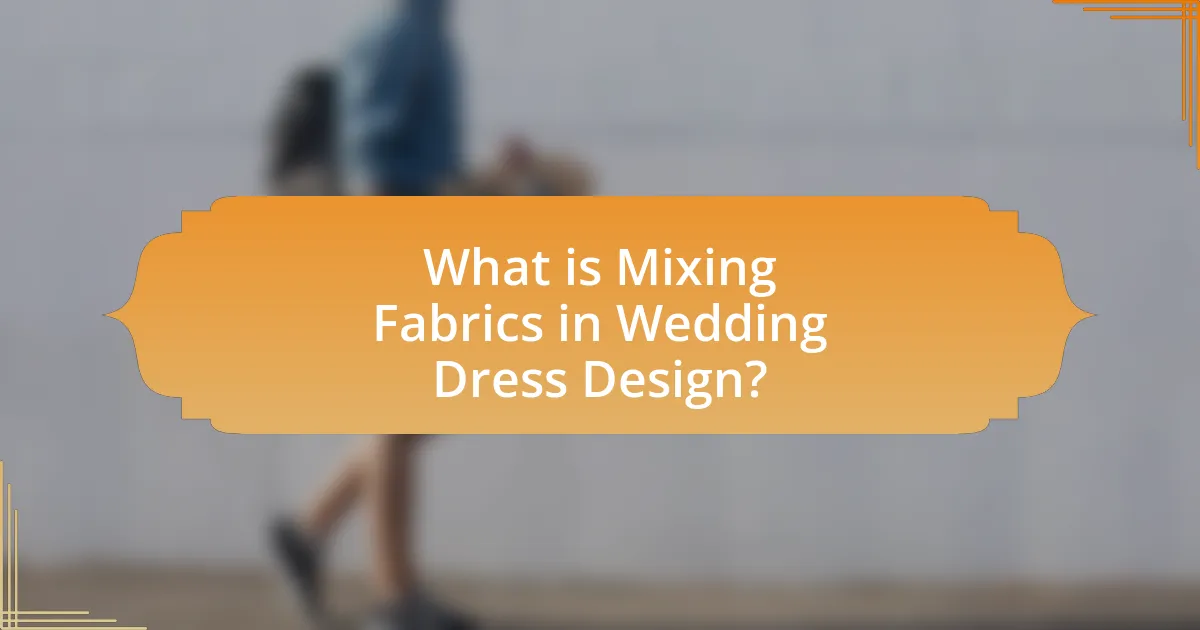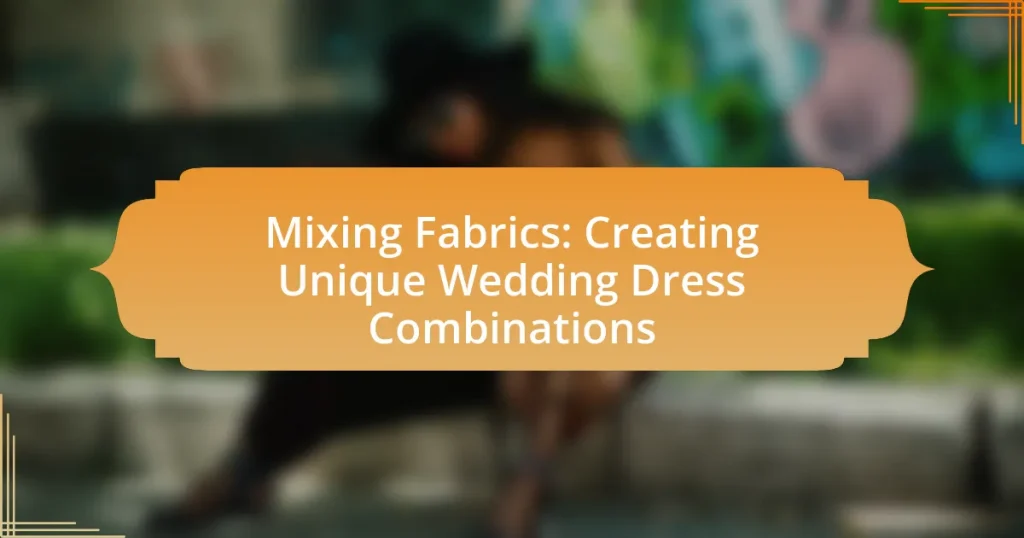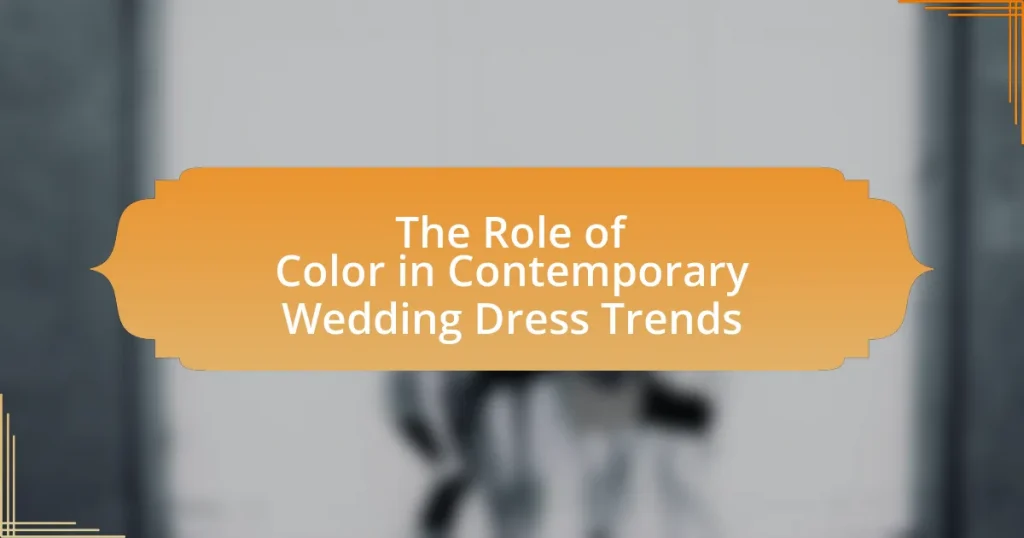Mixing fabrics in wedding dress design is a technique that combines various textile materials to create unique and visually appealing garments. This article explores how mixing fabrics enhances the overall design by adding texture, visual interest, and personalization, while also discussing common fabric types used in wedding dresses, such as satin, lace, and tulle. It highlights the importance of fabric choice in influencing silhouette, fit, and comfort, as well as practical considerations for care and maintenance. Additionally, the article provides insights into effective techniques for combining fabrics, common mistakes to avoid, and tips for creating distinctive wedding dresses through thoughtful fabric mixing.

What is Mixing Fabrics in Wedding Dress Design?
Mixing fabrics in wedding dress design refers to the technique of combining different textile materials to create a unique and visually appealing garment. This approach allows designers to enhance the aesthetic and functional qualities of the dress, such as texture, drape, and comfort. For instance, a designer might blend silk for its luxurious sheen with lace for intricate detailing, resulting in a dress that is both elegant and romantic. This method is supported by the fashion industry’s trend towards personalization and innovation, as seen in various bridal collections that showcase diverse fabric combinations to cater to individual tastes and styles.
How does mixing fabrics enhance the overall design of a wedding dress?
Mixing fabrics enhances the overall design of a wedding dress by creating visual interest and texture contrast. This technique allows designers to combine different materials, such as lace, satin, and tulle, to achieve a multidimensional look that can elevate the gown’s aesthetic appeal. For instance, the use of lace overlays on satin can add intricate detailing while maintaining a smooth silhouette. Additionally, varying fabric weights can influence the dress’s drape and movement, contributing to a more dynamic appearance as the bride moves. This approach not only personalizes the gown but also reflects the bride’s unique style, making the dress more memorable and distinctive.
What types of fabrics are commonly used in wedding dress design?
Commonly used fabrics in wedding dress design include satin, lace, tulle, chiffon, and organza. Satin is favored for its luxurious sheen and smooth texture, making it ideal for structured gowns. Lace adds intricate detailing and a romantic touch, often used for overlays or sleeves. Tulle is lightweight and airy, perfect for creating voluminous skirts or veils. Chiffon offers a soft drape and flow, commonly used in layers or flowing silhouettes. Organza, a stiffer fabric, is often used for creating structured elements or adding volume to skirts. These fabrics are chosen for their aesthetic qualities and how they contribute to the overall design and feel of the wedding dress.
How do different fabrics interact with each other in a dress?
Different fabrics in a dress interact through their varying properties, such as texture, weight, and drape, which can influence the overall silhouette and movement of the garment. For instance, a lightweight chiffon layered over a heavier satin can create a flowing effect while maintaining structure, as the chiffon adds softness and airiness, while the satin provides support and shape. Additionally, the way fabrics respond to light can enhance visual interest; for example, a matte fabric paired with a shiny one can create contrast that highlights design elements. This interaction is crucial in wedding dress design, where the combination of fabrics can evoke specific aesthetics and enhance the wearer’s comfort and mobility.
Why is fabric choice important in creating unique wedding dresses?
Fabric choice is crucial in creating unique wedding dresses because it directly influences the dress’s silhouette, texture, and overall aesthetic. Different fabrics, such as silk, lace, and tulle, offer varying levels of structure and drape, allowing designers to achieve distinct looks that reflect individual styles. For instance, silk provides a luxurious sheen and fluidity, while lace adds intricate detailing and a romantic feel. The combination of these fabrics can enhance the uniqueness of a wedding dress, as seen in trends where designers mix materials to create depth and visual interest. This practice not only personalizes the gown but also caters to the bride’s vision, making fabric selection a fundamental aspect of wedding dress design.
What role does fabric play in the silhouette and fit of a wedding dress?
Fabric significantly influences the silhouette and fit of a wedding dress by determining its structure, drape, and overall appearance. Different fabrics, such as satin, tulle, and lace, possess unique properties that affect how a dress falls on the body; for instance, satin provides a smooth, structured look, while tulle offers a light, airy feel that can create volume. The choice of fabric also impacts the dress’s ability to contour to the wearer’s shape, with stiffer materials allowing for more defined silhouettes and softer fabrics enabling a more relaxed fit. This relationship between fabric and design is crucial, as it directly affects the aesthetic and comfort of the gown, ensuring it complements the bride’s figure and style preferences.
How can fabric choice influence the overall aesthetic of the dress?
Fabric choice significantly influences the overall aesthetic of a dress by determining its texture, drape, and visual appeal. Different fabrics, such as silk, lace, or tulle, create distinct looks; for instance, silk offers a luxurious sheen and smooth drape, while lace adds intricate detail and a romantic feel. The weight and structure of the fabric also affect how the dress falls and moves, impacting the silhouette and overall style. For example, heavier fabrics like satin provide a structured look, while lighter fabrics like chiffon create a flowing, ethereal appearance. This relationship between fabric and aesthetic is crucial in design, as it allows designers to evoke specific moods and themes, enhancing the dress’s visual storytelling.

What are the Benefits of Mixing Fabrics for Wedding Dresses?
Mixing fabrics for wedding dresses offers several benefits, including enhanced texture, visual interest, and improved functionality. By combining different materials, designers can create unique looks that stand out, as each fabric contributes distinct qualities such as sheen, drape, and structure. For instance, pairing lace with satin can provide a romantic aesthetic while ensuring the dress maintains its shape. Additionally, mixing fabrics can enhance comfort; breathable materials can be used in areas requiring flexibility, while structured fabrics can provide support in others. This approach allows for greater creativity and personalization, catering to individual preferences and styles, ultimately resulting in a one-of-a-kind wedding dress.
How can mixing fabrics create unique textures and visual interest?
Mixing fabrics can create unique textures and visual interest by combining different material properties, such as sheen, weight, and drape. For instance, pairing a lightweight chiffon with a heavier satin can produce a striking contrast that enhances the overall aesthetic of a garment. This technique allows designers to play with tactile sensations and visual depth, making the piece more engaging. Historical examples include the use of lace overlays on silk gowns, which not only add intricate detail but also create a dynamic interplay of light and shadow. Such combinations can elevate a wedding dress, making it distinctive and memorable.
What are some examples of successful fabric combinations in wedding dresses?
Successful fabric combinations in wedding dresses include lace with satin, tulle with chiffon, and organza with silk. Lace combined with satin creates a classic and elegant look, as the intricate patterns of lace contrast beautifully with the smoothness of satin. Tulle paired with chiffon offers a light and airy feel, perfect for a romantic aesthetic, while organza and silk together provide a luxurious texture, with organza’s crispness enhancing the softness of silk. These combinations are popular in bridal fashion, as they balance structure and flow, catering to various styles and preferences.
How does mixing fabrics allow for personalization in wedding dress design?
Mixing fabrics in wedding dress design allows for personalization by enabling designers to combine different textures, colors, and patterns, which can reflect the individual style and preferences of the bride. This approach allows for the creation of unique combinations that can enhance the overall aesthetic and emotional significance of the dress. For instance, incorporating lace with satin can provide a romantic feel, while blending tulle with chiffon can add a whimsical touch. The versatility of fabric mixing not only caters to diverse tastes but also allows for adjustments in silhouette and fit, ensuring that each dress is tailored to the bride’s vision.
What practical considerations should be taken into account when mixing fabrics?
When mixing fabrics, it is essential to consider the compatibility of the materials in terms of texture, weight, and care requirements. Different fabrics can behave differently when combined; for instance, heavier fabrics may not drape well with lighter ones, leading to an unbalanced appearance. Additionally, the care instructions for each fabric should align to ensure that the entire garment can be maintained properly without damaging any component. For example, mixing a delicate silk with a machine-washable cotton may complicate cleaning processes. Understanding these factors helps in achieving a cohesive and functional design.
How do different fabrics affect the dress’s weight and comfort?
Different fabrics significantly influence a dress’s weight and comfort. Lightweight fabrics like chiffon and organza create airy, flowing dresses that are comfortable for warm weather, while heavier fabrics such as satin and taffeta add structure but increase the overall weight, potentially affecting comfort during extended wear. For instance, a study published in the Journal of Textile Science indicates that natural fibers like cotton and linen provide breathability, enhancing comfort, whereas synthetic fibers may trap heat, leading to discomfort. Thus, the choice of fabric directly impacts both the physical weight of the dress and the wearer’s comfort level.
What are the care and maintenance considerations for mixed fabric dresses?
Care and maintenance considerations for mixed fabric dresses include following specific washing instructions, using appropriate detergents, and avoiding high heat during drying. Mixed fabric dresses often combine materials like silk, polyester, and lace, which can have different care requirements. For instance, hand washing or using a gentle cycle in cold water is recommended to prevent damage. Additionally, using a mild detergent helps preserve the integrity of the fabrics. Air drying is preferable to prevent shrinkage or melting of synthetic fibers, which can occur with high heat. Proper storage, such as hanging or using breathable garment bags, also helps maintain the dress’s shape and fabric quality.

How to Successfully Mix Fabrics in Wedding Dress Design?
To successfully mix fabrics in wedding dress design, choose complementary materials that enhance the overall aesthetic and functionality of the dress. For instance, combining a structured fabric like satin with a softer fabric such as lace can create a beautiful contrast while providing both support and delicacy. This approach is validated by the fact that many designers utilize this technique to achieve depth and texture in their creations, as seen in collections from renowned fashion houses like Vera Wang and Pronovias, which often feature layered fabrics to enhance visual interest and movement.
What techniques can be used to effectively combine different fabrics?
To effectively combine different fabrics, techniques such as layering, contrasting textures, and color coordination can be employed. Layering involves placing one fabric over another to create depth and visual interest, while contrasting textures, like pairing smooth silk with rough lace, enhances the overall aesthetic. Color coordination ensures that the chosen fabrics complement each other, which can be achieved through color theory principles, such as analogous or complementary color schemes. These techniques are widely used in fashion design, particularly in creating unique wedding dress combinations, where the interplay of fabrics can significantly impact the garment’s overall look and feel.
How can layering techniques enhance the design of a wedding dress?
Layering techniques can enhance the design of a wedding dress by adding depth, texture, and visual interest. By incorporating multiple layers of different fabrics, designers can create a dynamic silhouette that captures light and movement, making the dress more visually appealing. For instance, a top layer of delicate lace over a satin base can create a romantic effect, while layers of tulle can add volume and ethereality. This approach allows for the combination of various materials, such as silk, chiffon, and organza, which can be tailored to achieve specific aesthetics and comfort levels. The use of layering also enables the incorporation of intricate details, such as embroidery or beading, which can be highlighted through the transparent or semi-transparent layers, enhancing the overall design and uniqueness of the wedding dress.
What sewing techniques are best for working with multiple fabrics?
The best sewing techniques for working with multiple fabrics include using a walking foot, employing French seams, and utilizing bias binding. A walking foot helps to evenly feed different fabric layers through the sewing machine, preventing slipping and puckering, which is crucial when combining fabrics with varying weights and textures. French seams provide a clean finish and added durability, making them ideal for delicate fabrics often used in wedding dresses. Bias binding allows for smooth curves and edges, accommodating the unique shapes that may arise when mixing fabrics. These techniques enhance the overall quality and appearance of the final garment, ensuring that the diverse materials work harmoniously together.
What are common mistakes to avoid when mixing fabrics?
Common mistakes to avoid when mixing fabrics include ignoring fabric weight and drape, which can lead to an unbalanced look. For instance, pairing a heavy satin with a lightweight chiffon may result in awkward silhouettes. Additionally, failing to consider texture compatibility can create visual discord; for example, mixing a rough fabric like burlap with a smooth silk can clash aesthetically. Another mistake is neglecting color harmony; using fabrics that do not complement each other can detract from the overall design. Lastly, not testing fabric combinations together before finalizing choices can result in unexpected outcomes, as the interaction of different materials can alter the intended appearance.
How can poor fabric choices impact the overall design and wearability?
Poor fabric choices can significantly compromise the overall design and wearability of a garment. For instance, selecting a fabric that lacks the necessary drape can result in a wedding dress that does not flow as intended, leading to an unflattering silhouette. Additionally, fabrics that are not breathable can cause discomfort, making it difficult for the wearer to enjoy their special day. Research indicates that the choice of fabric affects not only the aesthetic appeal but also the functionality of clothing; for example, a study published in the Journal of Fashion Technology & Textile Engineering highlights that fabric properties directly influence garment performance and user satisfaction. Therefore, poor fabric selection can detract from both the visual impact and the comfort of a wedding dress.
What should be considered to ensure harmony in fabric combinations?
To ensure harmony in fabric combinations, one must consider the texture, weight, and color of each fabric. Textures should complement each other; for instance, pairing a smooth satin with a textured lace can create visual interest without clashing. The weight of the fabrics should also be compatible; combining lightweight fabrics with heavier ones can lead to an unbalanced look. Additionally, color coordination is crucial; using a cohesive color palette that includes complementary or analogous colors can enhance the overall aesthetic. These principles are supported by design theories that emphasize the importance of balance and unity in visual compositions.
What tips can help in creating a unique wedding dress through fabric mixing?
To create a unique wedding dress through fabric mixing, consider combining different textures and weights to achieve visual interest and depth. For instance, pairing a lightweight chiffon with a heavier satin can create a stunning contrast that enhances the overall design. Additionally, using fabrics with varying patterns, such as lace over a solid base, can add complexity and uniqueness to the dress. Historical examples, such as the use of tulle and silk in haute couture, demonstrate that mixing fabrics can elevate a garment’s aesthetic. By thoughtfully selecting complementary colors and textures, designers can craft a wedding dress that stands out while maintaining elegance.



